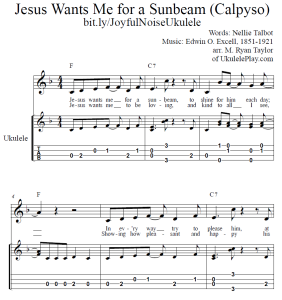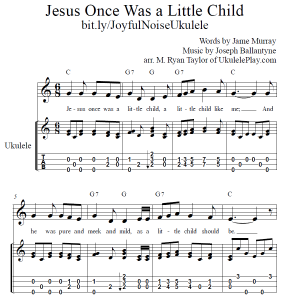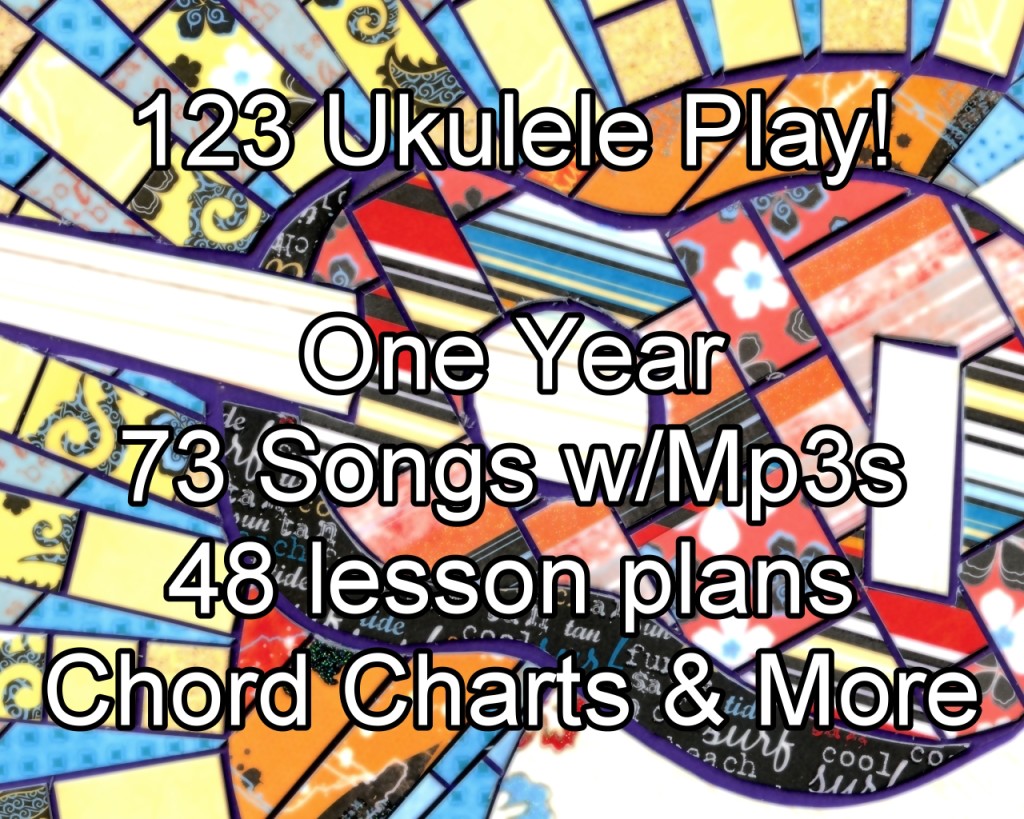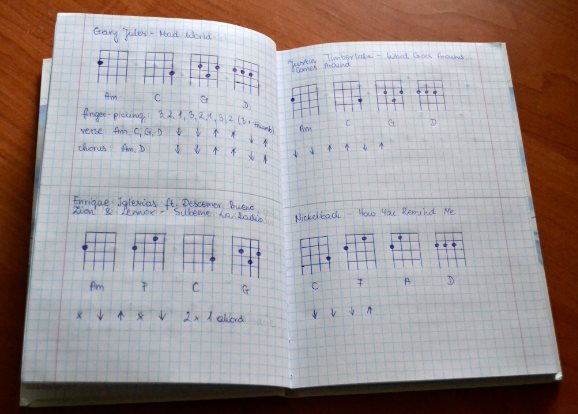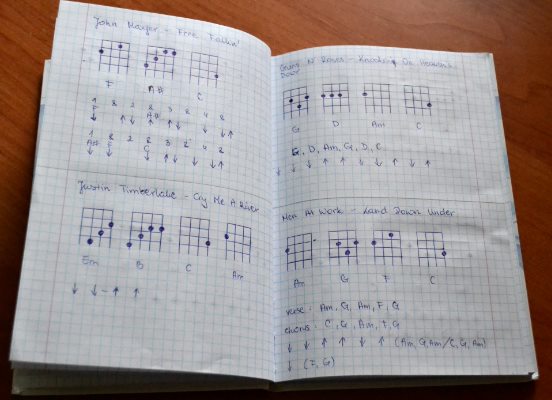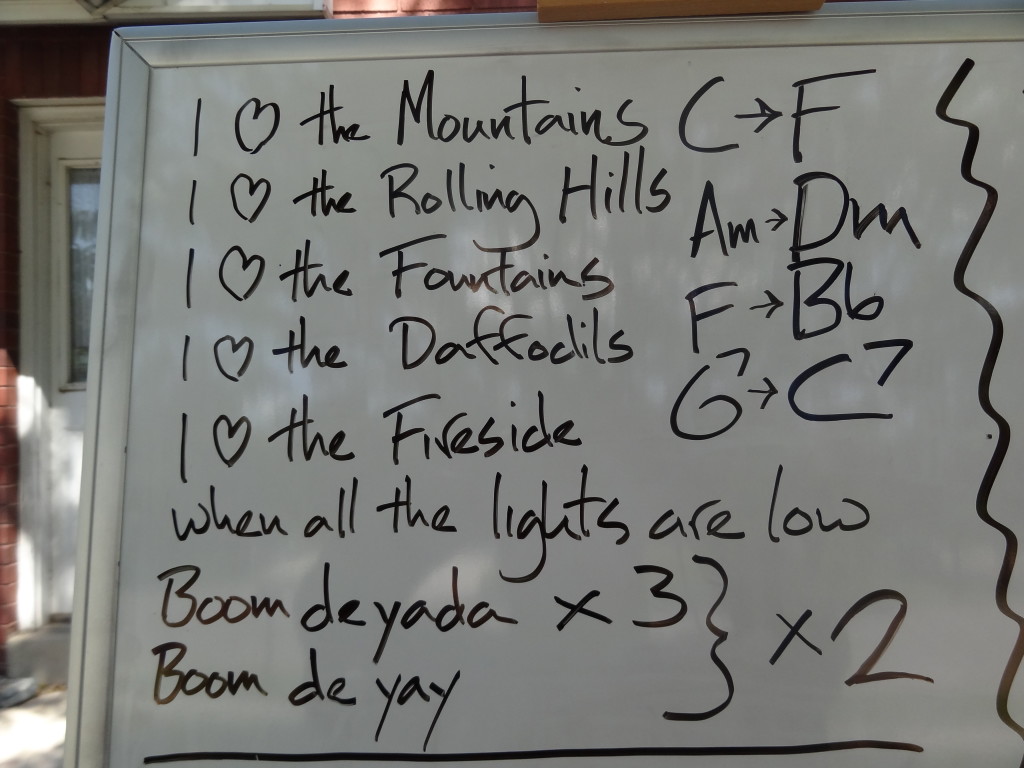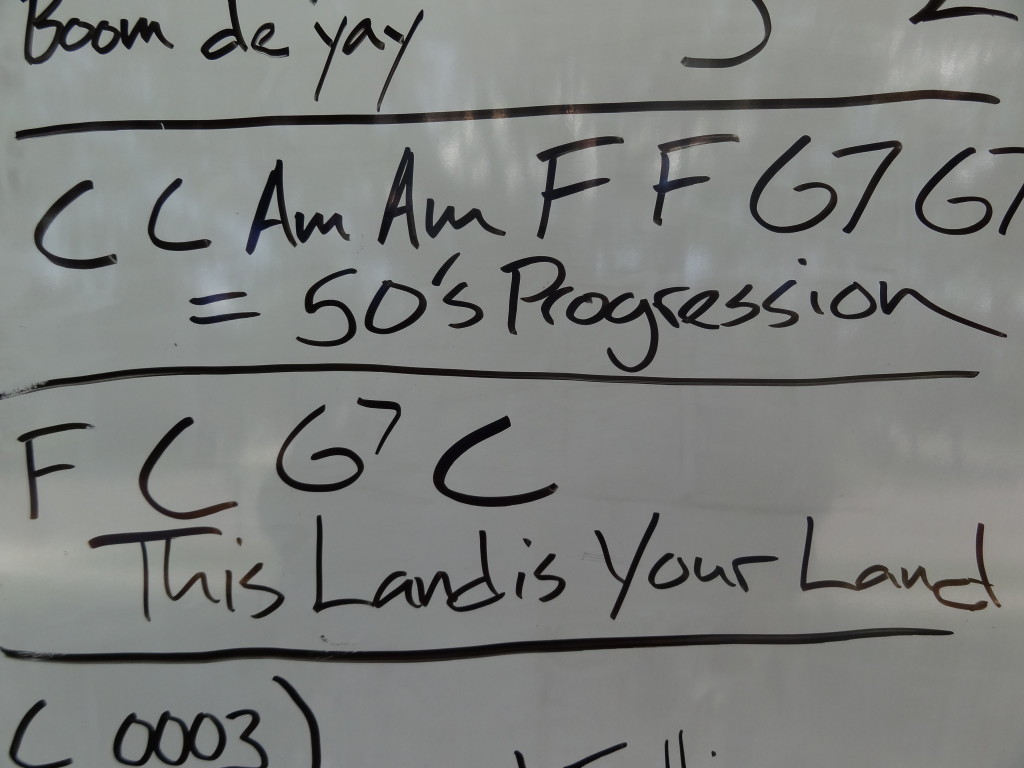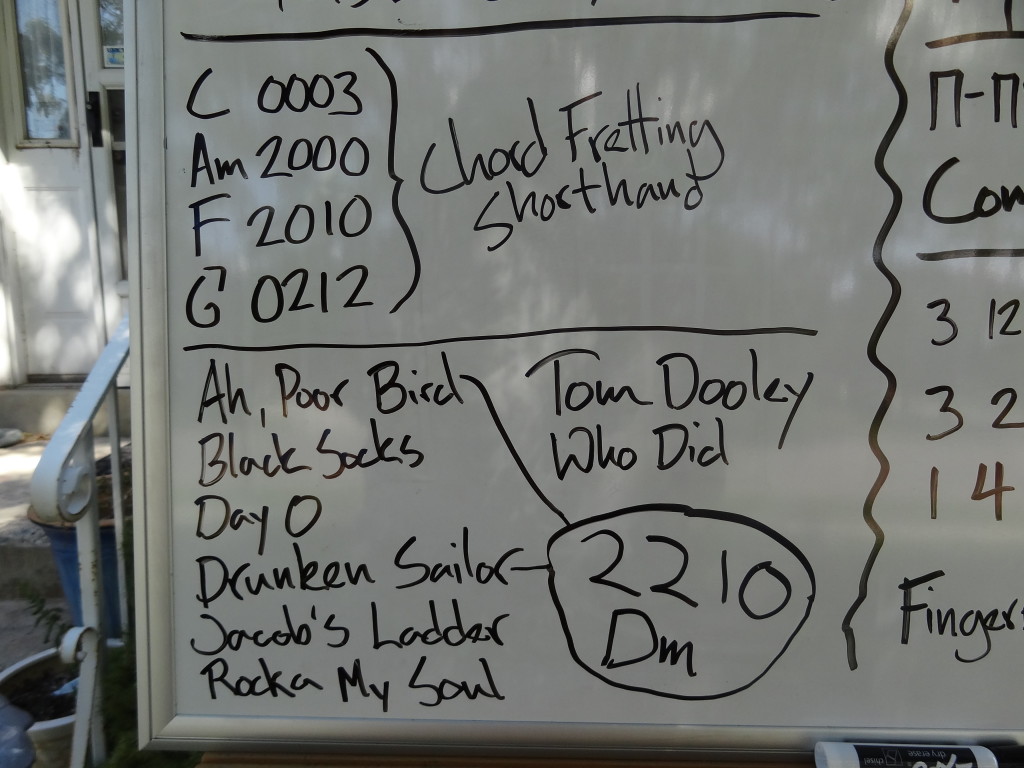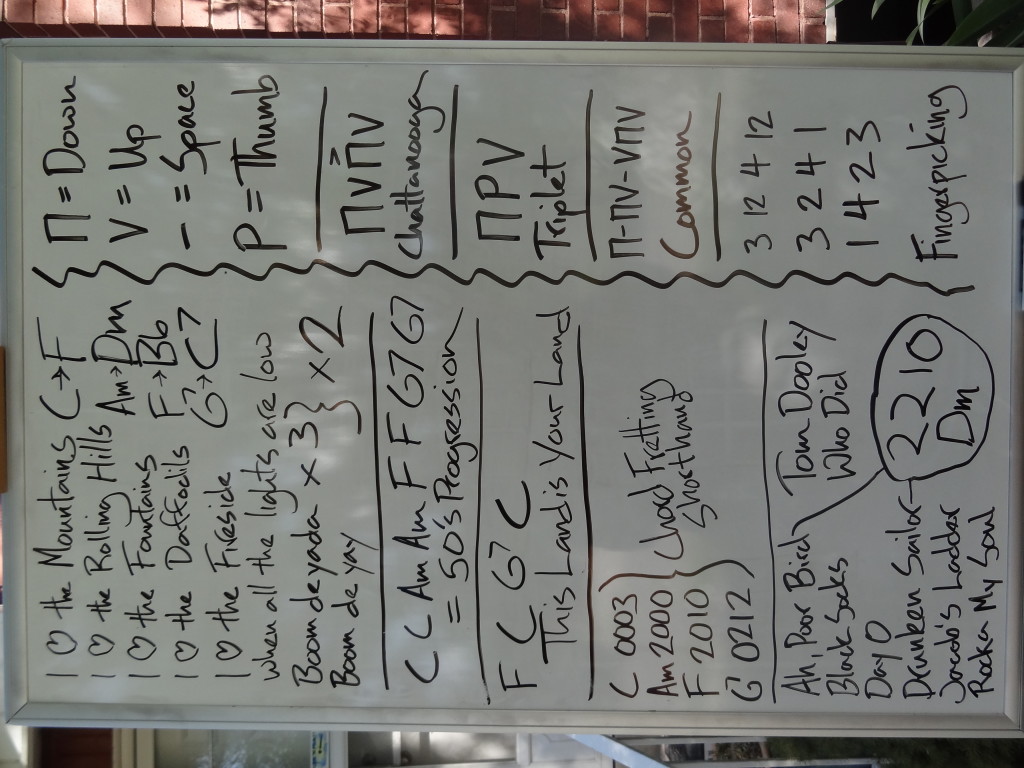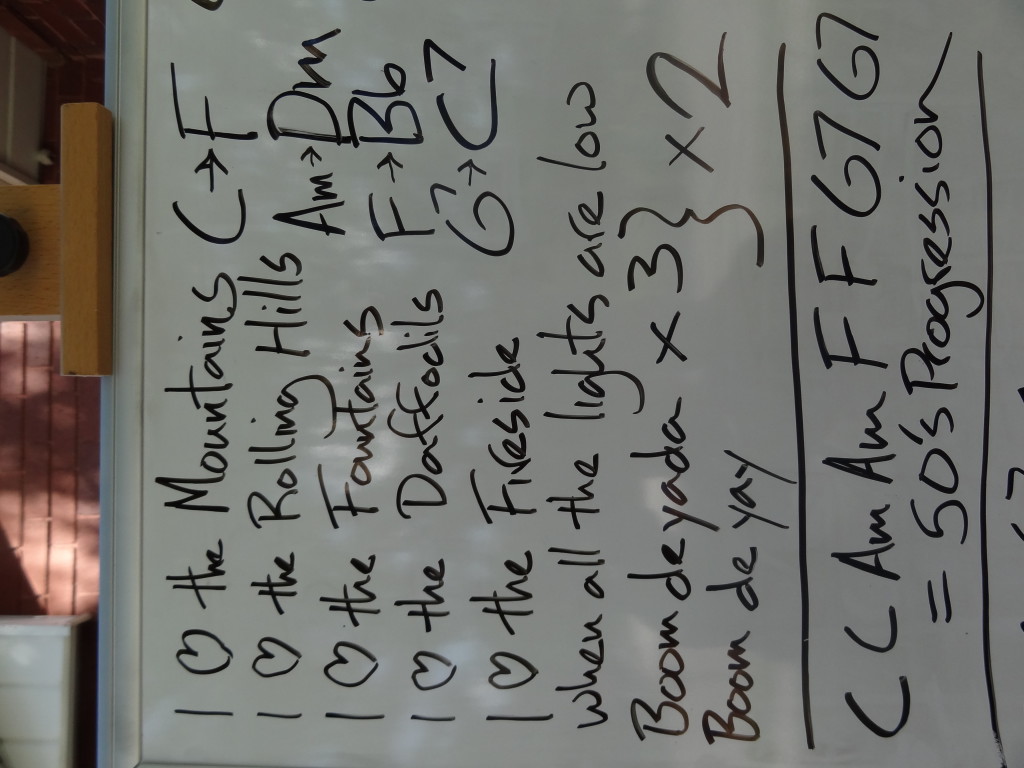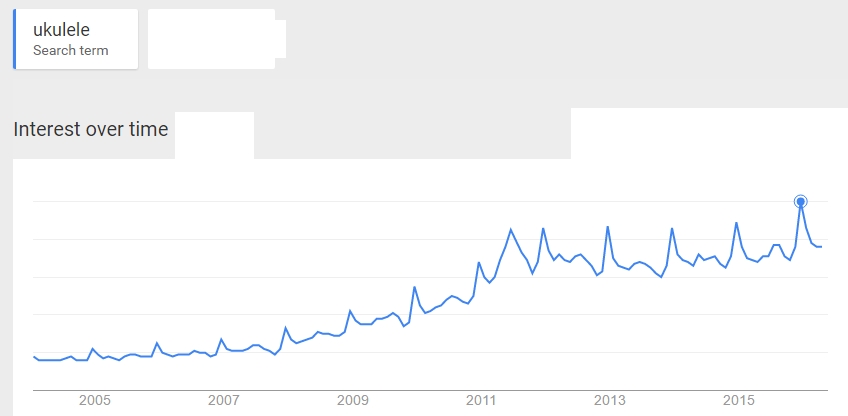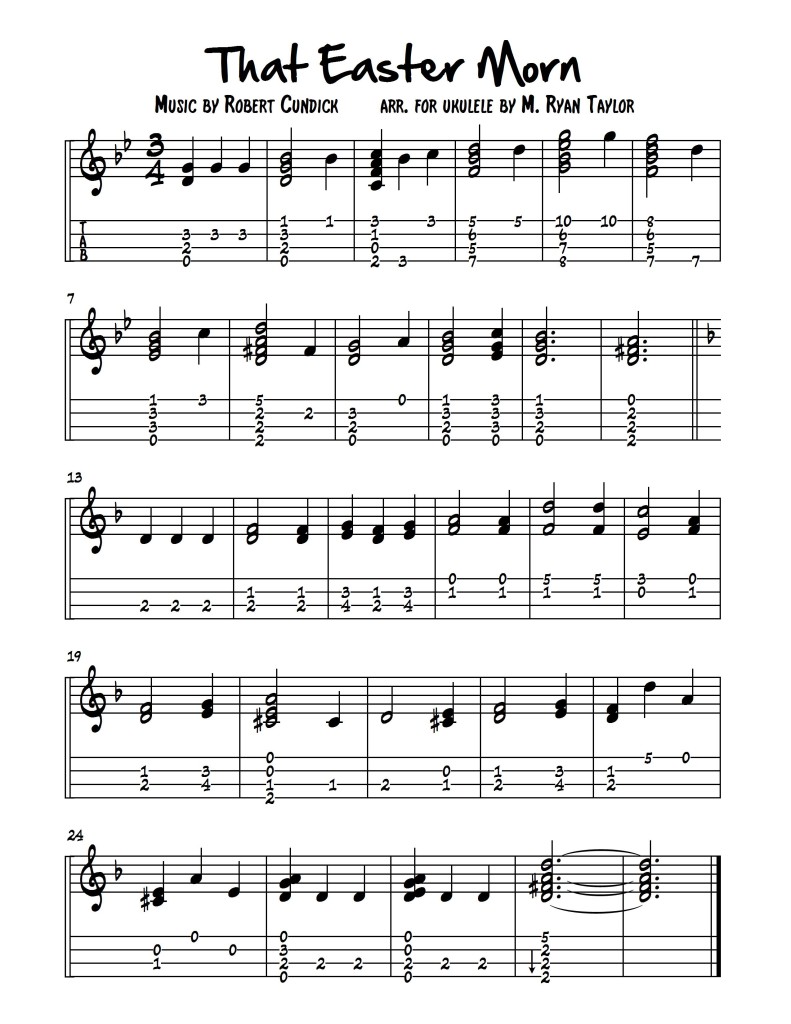Category Archives: All UkulelePlay! Blog Posts
We Three Kings
A new arrangement of the classic Christmas / Epiphany carol:
- We Three Kings : Vocal TRIO with chord voicings & fingerpicking instructions for one or more ukuleles
You can find more Christmas music for Ukulele groups, orchestras and ensembles at http://ukuleleplay.com/for-ukulele-ensembles/
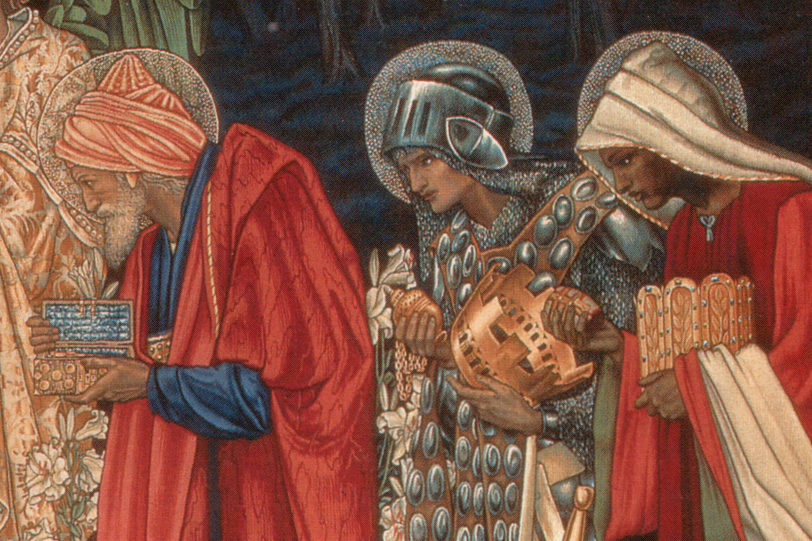
Review of 123 Ukulele Play! a one-year curriculum for schools
NEW! 123 Ukulele Play! : a curriculum for ukulele in the classroom
also on Teachers Pay Teachers and on Amazon. Find AUDIO here.
Review by Karin Kott
Full disclosure: I received this curriculum for free to review. I am starting a ukulele club in my middle school and this curriculum will be one of my resources.
This curriculum is a great resource for teachers. Intended to be used at the elementary school level, it is jam packed with information. One thing that I particularly appreciated was Mr. Taylor’s inclusion of interesting historical tidbits to give context to the songs.
At first glance, it seems as though quite a few concepts are introduced all at once: strumming, rhythm and note reading, chord diagrams, basic music theory, to name a few. Reading through it again, it becomes plain that Mr. Taylor has actually built in a great deal of flexibility into his curriculum.
For instance, the introductory songs are short, which is good—having the students learn short songs sets attainable goals, and therefore gives students a sense of rapid progression and accomplishment; second, this allows the teacher to revisit the song at different levels (once the melody or chords for the song are learned, the students can then revisit it but with specific strums, etc). This structure allows the teacher the opportunity to layer (scaffold) concepts on a familiar song while encouraging mastery.
Of course, as the curriculum progresses, the song selection becomes more diverse, the songs longer and more challenging, with more complex meters and rhythms, with more challenging techniques, including (but not limited to) IUC, Island, chunk/chnk strumming, and even some finger picking.
If you are thinking about starting up a uke program, I’d recommend checking out this curriculum.
Jesus Wants Me for a Sunbeam (Calypso)
6/8 songs adapt really easily to a Calypso-style 4/4. Except for a couple of spots, I would rate this one as very easy. Enjoy!
Listen to the 6/8 version at LDS.org.
Lyrics
1. Jesus wants me for a sunbeam,
To shine for him each day;
In ev’ry way try to please him,
At home, at school, at play.
2. Jesus wants me to be loving
And kind to all I see,
Showing how pleasant and happy
His little one can be.
Chorus
A sunbeam, a sunbeam,
Jesus wants me for a sunbeam.
A sunbeam, a sunbeam,
I’ll be a sunbeam for him.
Words: Nellie Talbot
Music: Edwin O. Excell, 1851-1921
Jesus Once Was a Little Child : Tablature – Vocal – Chords
This lovely little children’s primary song pulled at my heartstrings when I was 5 and still does today. You can listen to a piano version of the tune on LDS.org’s music site. Enjoy!
Lyrics
1. — Jesus once was a little child,
A little child like me;
And he was pure and meek and mild,
As a little child should be.
So, little children,
Let’s you and I
Try to be like him,
Try, try, try.
2. He played as little children play
The pleasant games of youth;
But he never got vexed if the game went wrong,
And he always spoke the truth.
So, little children,
Let’s you and I
Try to be like him,
Try, try, try.
Words: James R. Murray, 1841–1905
Music: Joseph Ballantyne, 1868–1944
Tell Me the Stories of Jesus : Tablature – Vocal – Chords
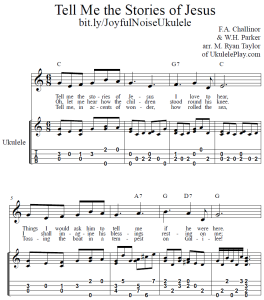 Tell Me the Stories of Jesus : Tab-Vocal-Chords arr. M. Ryan Taylor
Tell Me the Stories of Jesus : Tab-Vocal-Chords arr. M. Ryan Taylor
A beloved ‘primary’ song arranged for solo ukulele, or with vocals and chords (duet or trio). You can see/listen to piano sheet music in the key of Bb at Tell Me the Stories of Jesus at LDS.org
1. Tell me the stories of Jesus I love to hear,
Things I would ask him to tell me if he were here.
Scenes by the wayside, tales of the sea,
Stories of Jesus, tell them to me.
2. Oh, let me hear how the children stood round his knee.
I shall imagine his blessings resting on me;
Words full of kindness, deeds full of grace,
All in the love-light of Jesus’ face.
3. Tell me, in accents of wonder, how rolled the sea,
Tossing the boat in a tempest on Galilee!
And how the Master, ready and kind,
Chided the billows and hushed the wind.
Words: W. H. Parker, 1845–1929
Music: Frederic A. Challinor, 1866–1952
Arr.: M. Ryan Taylor
A one-year Curriculum for Teaching beginning Ukulele in the Classroom
https://youtu.be/3F9dGuMXBa0
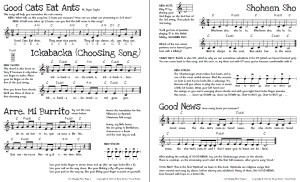 NEW! 123 Ukulele Play! : a curriculum for ukulele in the classroom
NEW! 123 Ukulele Play! : a curriculum for ukulele in the classroom
also on Teachers Pay Teachers and on Amazon. Find AUDIO here.
123 Ukulele Play! offers a step-by-step learning program for ukulele using developmental principles one might find in a Kodaly-based program, only with ukulele as a springboard for student enthusiasm. 73 songs are included in the student manual along with 48 lesson plans to help guide you through the process of teaching them. Also included are individual MP3 files for each of the songs, chord charts for the students as well as large chord charts to print and hang up on the walls.
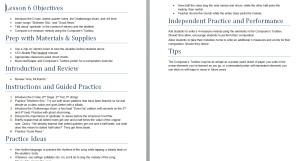 After the basics and Christmas units (secular alternates are included for any religious songs), classical masterworks are interspersed with units on New Years Goals, Americana (for President’s Day), Irish Dance and finally a trip around the world to various island nations (Japan, Tonga, Australia), ending with Hawaiian songs as a nod to the instrument’s birthplace.
After the basics and Christmas units (secular alternates are included for any religious songs), classical masterworks are interspersed with units on New Years Goals, Americana (for President’s Day), Irish Dance and finally a trip around the world to various island nations (Japan, Tonga, Australia), ending with Hawaiian songs as a nod to the instrument’s birthplace.
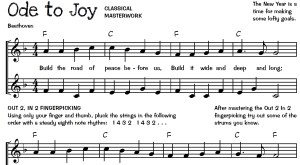 About the author: M. Ryan Taylor is the author of a number of ukulele books aimed at beginning players, including Two Chord Camp Songs for Ukulele, The Two Chord Companion, Two Chord Christmas Songs, Christmas on 34th Street and more that you can find on UkulelePlay.com. He is a Kodaly-certified developmental education specialist and has worked with elementary-age children as the director of the American Fork Children’s Choir since 2010. He also directs the Happy Valley Ukes, an adult community ukulele orchestra, and organizes The Original Utah Uke Fest, a full day of free concerts, open mics, workshops and more that promotes the guitar’s tiny cousin. Taylor also travels to teach Ukulele Bootcamps wherever the wind might blow him. Catch him singing at https://www.facebook.com/uke.n.me/ or http://ukuleleplay.com/uke-and-me/ or even https://www.youtube.com/watch?v=FI-yslLxG-k&list=PLr6L7Q-AOghUzk4-VnmQku_-UISAgSfXO
About the author: M. Ryan Taylor is the author of a number of ukulele books aimed at beginning players, including Two Chord Camp Songs for Ukulele, The Two Chord Companion, Two Chord Christmas Songs, Christmas on 34th Street and more that you can find on UkulelePlay.com. He is a Kodaly-certified developmental education specialist and has worked with elementary-age children as the director of the American Fork Children’s Choir since 2010. He also directs the Happy Valley Ukes, an adult community ukulele orchestra, and organizes The Original Utah Uke Fest, a full day of free concerts, open mics, workshops and more that promotes the guitar’s tiny cousin. Taylor also travels to teach Ukulele Bootcamps wherever the wind might blow him. Catch him singing at https://www.facebook.com/uke.n.me/ or http://ukuleleplay.com/uke-and-me/ or even https://www.youtube.com/watch?v=FI-yslLxG-k&list=PLr6L7Q-AOghUzk4-VnmQku_-UISAgSfXO
Ukulele Bootcamp : Utah I-15 Mini Tour
 Ukulele Bootcamp will be on the road along the Utah I-15 corridor:
Ukulele Bootcamp will be on the road along the Utah I-15 corridor:
- March 17th in Murray (Completed)
- March 30th in Washington City (Completed)
- April 14th in Wallsburg
Learn to tune, hold, chord, strum, and sing along with your ukulele; all the basics you need to know to get you started on a life filled with ukulele bliss.
About the Teacher: M. Ryan Taylor of UkulelePlay.com is the organizer of The Original Utah Uke Fest (since 2012) and director of Happy Valley Ukes : Utahs Ukulele Orchestra, performing regularly across the Wasatch Front. Ryan also teaches Weekly Ukulele Classes in Utah & Ukulele Bootcamps. Ryan also leads the two Ukulele Youth Choirs of the American Fork Childrens Choir. In Ryans words, I came to the ukulele after seeing Jake Shimabukuros rendition of While my Guitar Gently Weeps on YouTube. Jake inspired me and after getting familiar with the basics I started a ukulele program through the American Fork Childrens Choir. It turned out there were just as many teens, adults, and seniors in the community who wanted to learn and I just kept going, creating new learning materials as I went. Ryan has degrees in Vocal Performance (Bachelor of Music) and Music Composition (Master or Music) and is a Kodaly-certified music education specialist. He has worked professionally as a performing singer, recording artist, composer of vocal music, and director of choirs.
Note: This All-Ages class moves at a fair clip and lasts for two and a half hours. Children under ten should be accompanied by an adult learner who can reinforce the concepts taught at home.
12 Carols of Christmastime : Lyrics/Chords & Video
VIDEOS
All 12 Carols in one video on Facebook (opens in new window), or All 12 Carols in separate videos in a YouTube playlist (opens in new window), or watch here:
ABOUT THE CAROLS
These carols were selected and adapted from my two ukulele Christmas books, The Two Chord Christmas Songbook and Christmas on 34th Street. They were chosen firstly on their merit as great carols, secondly as fairly well-known songs of the season and thirdly to offer good variety in a set that makes sense for performing/caroling. The order of the songs may seem random, but they are placed so that no two songs are in the same key in a row and the carols alternate between slow and fast-paced tunes. None of the carols has more than 4 chords and a number have only 2, which makes them ideal for beginners. You need only add a bit of interesting strumming/fingerpicking or some chord inversions to keep intermediate and advancing players interested. I’ve posted the lyrics/chords below.
I created the videos as teaching aids for my students and we’re planning a carol sing & strum mid-December for which I created the lyric/chord charts. I thought the material might be of use to others, so here it is! Merry Christmas! and Happy Caroling!
LYRICS/CHORDS
HE IS BORN
CHORUS
[F]He is born, the divine Christ Child,
Loud let us sing to [C7]greet His coming;
[F]He is born, the divine Christ Child,
Sound the pipes, let the [C7]trumpets [F]play.
1. [F]We have waited a [C7]thousand [F]years
Since the prophets’ [C7]first foretelling;
[F]We have waited a [C7]thousand [F]years,
Hail, our new-born [C7]Lord this day. [CHORUS]
2. [F]How the light a[C7]bout Him [F]shines,
round this perfect [C7]child of heaven!
[F]How the light a[C7]bout Him [F]shines,
Sweetly casting [C7]fear away. [CHORUS]
3. [F]Starlit is His [C7]humble [F]crib,
Ox and ass be[C7]side Him sleeping;
[F]Starlit is His [C7]humble [F]crib,
See His throne, a [C7]bed of hay. [CHORUS]
_______
WHAT CHILD IS THIS?
What [Dm]child is this, who, [C]laid to rest,
On [Dm]Mary’s lap is [A7]sleeping?
Whom [Dm]angels greet with [C]anthems sweet
While [Dm]shepherds [A7]watch are [Dm]keeping?
[F]This, this is [C]Christ the king,
Whom [Dm]shepherds guard and [A7]angels sing;
[F]Haste, haste to [C]bring him laud,
The [Dm]Babe, the [A7]Son of [Dm]Mary!
So [Dm]bring him incense, [C]gold, and myrrh;
Come, [Dm]peasant, king, to [A7]own him.
The [Dm]King of kings sal[C]vation brings;
Let [Dm]loving [A7]hearts en[Dm]throne him.
[F]Raise, raise the [C]song on high,
The [Dm]virgin sings her [A7]lullaby;
[F]Joy, joy, for [C]Christ is born,
The [Dm]Babe, the [A7]Son of [Dm]Mary!
_______
O CHRISTMAS TREE
O [F]Christmas Tree, [C7]O [F]Christmas [Dm]Tree,
How [C7]steadfast are your [F]branches! :||
Your [F]boughs are green in [C7]summer’s clime
And through the snows of [F]wintertime.
O [F]Christmas Tree, [C7]O [F]Christmas [Dm]Tree,
How [C7]steadfast are your [F]branches!
O [F]Christmas Tree, [C7]O [F]Christmas [Dm]Tree,
What [C7]happiness be[F]falls me! :||
When [F]oft you’ve given [C7]us delight
In brightly shining [F]Christmas light!
O [F]Christmas Tree, [C7]O [F]Christmas [Dm]Tree,
What [C7]happiness be[F]falls me!
O [F]Christmas Tree, [C7]O [F]Christmas [Dm]Tree,
Your [C7]boughs have truly [F]taught me; :||
That [F]hope and love will [C7]ever be
The way to joy and [F]peace for me.
O [F]Christmas Tree, [C7]O [F]Christmas [Dm]Tree,
Your [C7]boughs have truly [F]taught me.
_______
GO TELL IT ON THE MOUNTAIN
CHORUS
[G]Go, tell it on the mountain
[D]Over the hills and [G]every[C]where
[G]Go, tell it on the mountain
[C6]That [G]Jesus [D7]Christ is [G]born.
1. While [G]shepherds [C]kept their [G]watching
O’er [D7]silent flocks by [G]night,
Be[G]hold through[C]out the [G]heavens
There [D]shone a [C]holy [D]light. [D7] [CHORUS]
2. The [G]shepherds [C]feared and [G]trembled
When [D7]lo above the [G]earth
Rang [G]out the [C]angel [G]CHORUS
That [D]hailed our [C]Savior’s [D]birth; [D7] [CHORUS]
3. Down [G]in a [C]lowly [G]manger
The [D7]humble Christ was [G]born;
And [G]God sent [C]out sal[G]vation
That [D]blessed [C]Christmas [D]morn. [D7] [CHORUS]
_______
I SAW THREE SHIPS
I [F]saw three [C7]ships come [F]sailing [C7]in
On [F]Christmas Day, on [C7]Christmas Day;
I [F]saw three [C7]ships come [F]sailing [C7]in
On [F]Christmas Day in the [C7]morn[F]ing.
And [F]what was [C7]in those [F]ships all [C7]three,
On [F]Christmas Day, on [C7]Christmas Day?
And [F]what was [C7]in those [F]ships all [C7]three,
On [F]Christmas Day in the [C7]morn[F]ing?
Our [F]Saviour [C7]Christ and [F]His la[C7]dy,
On [F]Christmas Day, on [C7]Christmas Day;
Our [F]Saviour [C7]Christ and [F]His la[C7]dy,
On [F]Christmas Day in the [C7]morn[F]ing.
And [F]all the [C7]bells on [C7]earth shall [F]ring,
On [F]Christmas Day, on [C7]Christmas Day;
And [F]all the [C7]bells on [F]earth shall [C7]ring,
On [F]Christmas Day in the [C7]morn[F]ing.
And [F]all the [C7]Angels in [F]Heaven shall [C7]sing,
On [F]Christmas Day, on [C7]Christmas Day;
And [F]all the [C7]Angels in [F]Heaven shall [C7]sing,
On [F]Christmas Day in the [C7]morn[F]ing.
_______
INFANT HOLY, INFANT LOWLY
Infant [G]holy, Infant [Am7]lowly,
Lying [G]crad[C]led [D7]in a [G]stall.
Oxen [G]lowing, little [Am7]knowing
That the [G]Babe [C]is [D7]Lord of [G]All.
Swift are [C]winging, [Am7]Angels [D7]singing,
Nowells [Em7]ringing, [Am7]Tidings [D7]bringing
That the [G]Babe [C]is [D7]Lord of [Em7]All,
[D7]That the [G]Babe [C]is [D7]Lord of [G]All.
Stars were [G]gleaming, shepherds [Am7]dreaming
And the [G]night [C]was [D7]dark and [G]chill.
Angels’ [G]story, manger [Am7]glory,
Shepherds [G]heard [C]it [D7]on the [G]hill.
Ah, that [C]singing! [Am7]Hear it [D7]ringing,
Earthward [Em7]winging, [Am7]Christmas [D7]bringing.
Hearken! [G]We [C]can [D7]hear it [Em7]still!
[D7]Hearken! [G]We [C]can [D7]hear it [G]still!
See the [G]clearness and the [Am7]nearness
Of the [G]bles[C]sed [D7]Christmas [G]star,
Leading, [G]guiding, wise men [Am7]riding
Through the [G]des[C]ert [D7]dark and [G]far.
Lovely [C]showing, [Am7]shining [D7]growing,
Onward [Em7]going, [Am7]gleaming [D7]glowing,
Leading [G]still, [C]our [D7]Christmas [Em7]Star.
[D7]Leading [G]still, [C]our [D7]Christmas [G]Star.
_______
JINGLE BELLS
[F]Dashing through the snow
In a one horse open [Bbadd9]sleigh
O’er the hills we [C]go
Laughing all the [F]way.
Bells on bobtail ring
Making spirits [Bbadd9]bright.
What fun it is to [C]ride and sing
A sleighing song to[F]night. [C7]Oh!
[F]Jingle bells jingle bells
Jingle all the way!
[Bbadd9]Oh, what fun it [F]is to ride
In a [G7]one horse open [Cadd9]sleigh!
[F]Jingle bells jingle bells
Jingle all the way!
[Bbadd9]Oh, what fun it [F]is to ride
In a [C7]one horse open [F]sleigh!
[G]Dashing through the snow
In a one horse open [C]sleigh
O’er the hills we [D7]go
Laughing all the [G]way.
Bells on bobtail ring
Making spirits [C]bright.
What fun it is to [D7]ride and sing
A sleighing song to[G]night. [D7]Oh!
[G]Jingle bells jingle bells
Jingle all the way!
[C]Oh, what fun it [G]is to ride
In a [A7]one horse open [D7]sleigh!
[G]Jingle bells jingle bells
Jingle all the way!
[C]Oh, what fun it [G]is to ride
In a [D7]one horse open [G]sleigh!
_______
JOLLY OLD ST. NICHOLAS
[F]Jolly old St. [C]Nicholas,
[Bbadd9]Lean your ear this [Dm7]way!
[Bbadd9]Don’t you tell a [F]single soul
[C]What I’m going to say.
[F]Christmas Eve is [C]coming soon!
[Bbadd9]Now, you dear old [Dm7]man.
[Bbadd9]Whisper what you’ll [F]bring to me;
[C]Tell me if you [F]can.
[F]When the clock is [C]striking twelve.
[Bbadd9]When I’m fast a[Dm7]sleep,
[Bbadd9]Down the chimney [F]broad and black,
[C]With your pack you’ll creep.
[F]All the stockings [C]you will find
[Bbadd9]Hanging in a [Dm7]row;
[Bbadd9]Mine will be the [F]shortest one,
[C]You’ll be sure to [F]know.
[F]Johnny wants a [C]pair of skates.
[Bbadd9]Susy wants a [Dm7]sled,
[Bbadd9]Nelly wants a [F]picture book;
[C]Yellow, blue and red;
[F]Now I think I’ll [C]leave to you
[Bbadd9]What to give the [Dm7]rest;
[Bbadd9]Choose for me, dear [F]Santa Claus,
[C]You will know the [F]best.
_______
PATAPAN
[Dm]Willie, take your little drum,
With your whistle, Robin, [A7]come.
When we hear the fife and [Dm]drum,
Turelurelu, [A7]patapatapan;
When we hear the fife and [Dm]drum:
Make your Christ mas [A7]frolic[Dm]some!
[Dm]Thus the men of olden days
Loved the King of Kings to [A7]praise;
When we hear the fife and [Dm]drum,
Turelurelu, [A7]patapatapan;
When we hear the fife and [Dm]drum:
Let your joyful [A7]voices [Dm]hum!
[Dm]God and man are now become
More at one than fife and [A7]drum;
Listen to this fife and [Dm]drum,
Turelurelu, [A7]patapatapan;
Listen to this fife and [Dm]drum,
And you never [A7]will suc[Dm]cumb!
_______
WHAT SHALL WE GIVE?
[C]What shall we [G7]give to the [C]Son of our [G7]Mary?
[C]What can we [G7]give that the [C]Child will en[G7]joy?
[C]First, we shall give Him a [G7]tray full of [C]raisins,
Then we shall offer sweet [G7]figs to the [C]Boy.
Tampatamta, give a [G7]tray full of [C]raisins,
Tampatamta, and sweet [G7]figs to the [C]Boy.
[C]What can we [G7]give the Be[C]loved of [G7]Mary?
[C]What can we [G7]give to her [C]beautiful [G7]Child?
[C]Raisins and olives and [G7]nutmeats and [C]honey,
Candy and figs and some [G7]cheese that is [C]mild.
Tampatamta, olives, [G7]nutmeats and [C]honey,
Tampatamta, and some [G7]cheese that is [C]mild.
[C]What can we [G7]sing Him? A [C]song of sweet [G7]beauty?
[C]What if we [G7]sing as those [C]angels a[G7]bove?
[C]”Peace and goodwill to the [G7]sons of the [C]morning,
Glory and praise to the [G7]Author of [C]Love.”
Tampatamta, all ye [G7]sons of the [C]morning,
Tampatamta, praise the [G7]Author of [C]Love.
_______
THE LITTLE CRADLE ROCKS
If [F]anybody asks you who I am,
[Bb7]who I am, [F]who I am,
If anybody asks you who I am,
[Bb7]Tell him I’m a child of [F]God.
CHORUS
The [F]little cradle rocks tonight in glory,
[Bb7]in glory, [F]in glory,
The little cradle rocks tonight in glory,
[Bb7]Christ child born in [F]glory!
[F]Peace on earth, Mary rock the cradle,
[Bb7]Rock the cradle, [F]rock the cradle,
Peace on earth, Mary rock the cradle,
[Bb7]Christ child born in [F]glory! [CHORUS]
The [F]Christ child’s passing, singing softly,
[Bb7]Singing softly, [F]singing softly,
The Christ child’s passing, singing softly,
[Bb7]Christ child born in [F]glory! [CHORUS]
If [F]anybody asks you who you are,
[Bb7]who you are, [F]who you are,
If anybody asks you who you are,
[Bb7]Tell him you’re a child of [F]God.
_______
SILENT NIGHT
[C]Silent night! Holy night!
[G7]All is calm, [C]all is bright,
[F]Round yon Virgin [C]Mother and Child!
[F]Holy Infant, so [C]tender and mild,
[G7]Sleep in heavenly [C]peace!
Sleep in [G7]heavenly [C]peace!
[C]Silent night! Holy night!
[G7]Shepherds quake [C]at the sight!
[F]Glories stream from [C]heaven afar,
[F]Heav’nly Hosts sing [C]Alleluia!
[G7]Christ, the Savior is [C]born!
Christ, the [G7]Savior is [C]born!
[C]Silent night! Holy night!
[G7]Son of God, [C]love’s pure light;
[F]Radiant beams from [C]Thy Holy Face,
[F]With the dawn of re[C]deeming grace,
[G7]Jesus, Lord, at Thy [C]Birth!
Jesus, [G7]Lord, at Thy [C]Birth!
Graph paper and the ukulele, it seems like such a simple idea, but…
Graph paper and the ukulele, it seems like such a simple idea, but I’ve never seen anyone use it before now (and I’ve seen a lot of ukulele ideas, tips and tricks). This idea comes from Patrycja Kozak, a member of the Ukulele Players (Uke Players) group on Facebook (shared with permission). She uses a graph paper notebook as her “song / chord / tip book,” and once you see it, you realize the perfect suitability of graph paper for this kind of notebook:
As you can see, the graph paper provides a perfect template for chord diagrams, and still allows you to write notes on the grid as if you were using lined paper. Thanks Patrycja for sharing!
Blue Skies Sing-along Video with Chords & Lyrics
https://youtu.be/DYoJt4fnAP8
“[Blue Skies] was composed in 1926 as a last-minute addition to the Rodgers and Hart musical Betsy… [It] was an instant success, with audiences on opening night demanding 24 encores of the piece…” ~Wikipedia
There are a boatload of chords in this song and some unusual progressions that come off as fresh but not weird (might be why it has stood the test of time so well – I particularly like the Cadd9 followed by the Daug). Here are the chords and their frettings:
[G 0232] [G7 0212] [C6 0000] [C7 0001] [Gsus4 0233] [Bm 4222] [F# 3121] [F#7 3424] [D7 2223] [B7 2322] [Em 0432] [Baug 0332] [C#m7b5 0102] [Cadd9 0005] [Daug 3225] [Bb7 1211] [Cm7 3333] [Cm 0333] [Eb7 3334]
Reading the above fret number chord diagrams for standard ukulele gCEA tuning:
1st digit = g string fret number
2nd digit = C string
3rd digit = E string fret number
4th digit = A string fret number
Blue Skies by Irving Berlin
[G]I was [G7]blue, just as
[C6]blue as [C7]I could [G]be [Gsus4] [G]
[G]Ev’ry [G7]day was a
[C6]cloudy [C7]day for [G]me [Gsus4] [G]
[Bm]Then good [F#]luck came a
[F#7]knocking at my [Bm]door [D7]
[G]Skies were [G7]gray, but they’re
[C6]not gray [C7]any[G]more [B7]
[Em]Blue skies [Baug] smiling at [G]me
[C#m7b5] Nothing but [G]blue skies [Cadd9]
[Daug]do I [G]see [B7]
[Em]Bluebirds [Baug] singing a [G]song
[C#m7b5] Nothing but [G]bluebirds [Cadd9]
[Daug] all day [G]long
[G]Never saw the [Bb7]sun
[Cm7]shining so [G]bright
[Cm]Never saw [G]things
[Eb7]going [D7]so [G]right
[G]Noticing the [Bb7]days
[Cm7]hurrying [G]by
[Cm]When your in [G]love
[Eb7]my how [D7]they [G]fly [B7]
[Em]Blue days [Baug] all of them [G]gone
[C#m7b5] Nothing but [G]blue skies [Cadd9]
[Daug] from now [G]on [Gsus4] [G]
For Educational Purposes Only
Ain’t Misbehavin’ (Fats Waller Cover) w/ Lyrics & Chords
https://www.youtube.com/watch?v=NDKBVVxIDHw
AIN’T MISBEHAVIN’ (Fats Waller Cover)
Posted for educational purposes only.
Chords in this song: C 0003, C#dim7 0101, Dm 2210, G 0232, C7 0001, F 2010, Fm 1013, Am 2000, G7 0212, E7 1202, A7 0100 & D7 2223
Reading the above fret number chord diagrams for standard ukulele gCEA tuning:
1st digit = g string fret number
2nd digit = C string
3rd digit = E string fret number
4th digit = A string fret number
[C] No one to [C#dim7]walk with
[Dm] All by my[G]self
[C] No one to [C7]talk with
But [F]I’m happy [Fm]on the shelf
[C] Ain’t misbe[Am]havin’
[Dm]I’m savin’ [G7]my love for
[E7]you [A7] [D7] [G7]
[C] I know for [C#dim7]certain
[Dm] The one I [G]love
[C] I’m through with [C7]flirtin’
It’s [F]just you I’m [Fm]thinkin’ of
[C] Ain’t misbe[Am]havin’
[Dm]I’m savin’ [G7]my love for
[C]you [Fm] [C] [E7]
[Am] Like Jack Horner
[F] In the corner
[Am] Don’t go nowhere
[A7] What do I care?
[G] Your kisses [Am]are worth
[D7]waitin’ [G7]for
[A7]Be[D7]lieve [G7]me
[C] I don’t stay [C#dim7]out late
[Dm] Don’t care to [G]go
[C] I’m home a[C7]bout eight
Just [F]me and my [Fm]radio
[C] Ain’t mis[Am]behavin’
[Dm ]I’m savin’ [G7]my love for
[C]you [Fm] [C]
Home Host Ukulele Bootcamp for your Town and Get Ukulele Gear
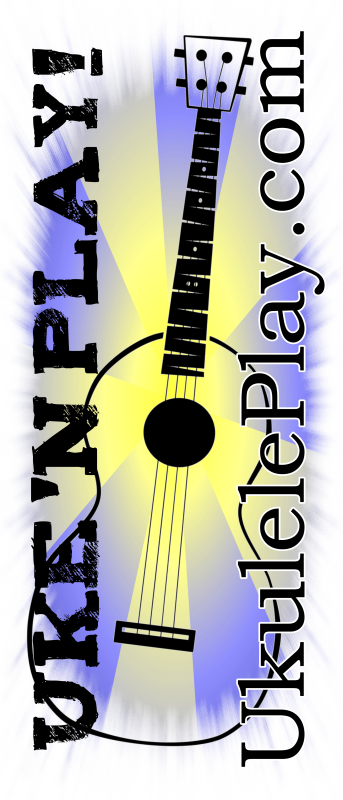 I’m touring along the Wasatch this Summer in the months of July and August 2017 and I’d love to bring a ukulele experience to your town. I get a place to teach; you bring ukulele joy to friends and family while earning some ukulele swag:
I’m touring along the Wasatch this Summer in the months of July and August 2017 and I’d love to bring a ukulele experience to your town. I get a place to teach; you bring ukulele joy to friends and family while earning some ukulele swag:
- Offer your home (or other space) with room to seat 15-20 people : get free attendance for yourself or a loved one.
- Help find the minimum 4 additional attendees by inviting your friends : get a free 2-Chord Camp Songs book.
- Help find 8 attendees : get the book and a free chromatic tuner.
- Help find 15 attendees : get the book, tuner and a free Eddy Finn Minnow Ukulele.
Details on Camps:
- Bootcamps are 2.5 hours in length and cover all the basics to get you started on the ukulele, including tuning, your first four chords, ten songs, the c-scale and much more.
- Cost per attendee is fifty-five dollars for traveling bootcamps. Ukuleles, tuners, straps and books are available at an additional cost.
- Available dates include Friday mornings, afternoons or evenings in July or August as well as the following Saturday mornings: July 1, 8, 22, 29, August 12, 19 & 26.
- Camps will travel to cities along the I-15 corridor from Bountiful to Nephi (will travel farther for larger groups – or with a travel stipend).
How to Book a Bootcamp:
- Send a photo or description of your space to hold the bootcamp in, along with dates that would work for you to ryan@ukuleleplay.com
- Once we agree on a date and time, I’ll send a sign up link and five-dollar off coupon code you can send to your friends (when folk use the coupon I’ll know you sent them to the form).
An ‘About the Teacher’ You Can Copy and Share:
- M. Ryan Taylor has helped hundreds upon hundreds of folk get their start on the ukulele. In addition to teaching ukulele camps for the Timpanogos Arts Foundation, Orem SCERA and the Spanish Fork Youth Arts Festival, Ryan is the organizer of The Original Utah Uke Fest (since 2012) and director of the Ukulele Youth Choir of the American Fork Children’s Choir as well as UFO HUM (Ukes for Others: Happy Ukulele Movement), an adult ukulele service group that performs regularly across the Wasatch Front. Over his years of teaching bootcamps, Ryan has refined a fast-paced and fun learning experience for those wanting to get going with the ukulele.
I Want Uke! Tee
 I Want Uke T-shirt. New!
I Want Uke T-shirt. New!
Uncle Sam invites Uke to show your true colors. Pick your color and get your shirt here: https://teechip.com/iwantuke for just $18.
Sizes Small-6X in a variety of cool and warm colors.
July 4th will be here before you know it. Order yours now and be prepared. 🙂
Cry Out, Cry Out : a new song
If you’ve been reading the blog lately, you’ll know I’ve been working on memorization. I started work on this song a couple weeks ago and wanted to get this out for Palm Sunday and just barely made it (lyrics and chords below the video – twitter me covers @mryantaylor – just 4 chords!). Hope you have a lovely Easter week. YouTube at https://youtu.be/SIOpUwD4xaI and audio at https://uke-n-me.bandcamp.com/track/cry-out-cry-out (for sharing). Hope you enjoy it!
Cry Out, Cry Out
Music & Lyrics by M. Ryan Taylor
{Verse 1}
I was [C]born to this [Am]world by blood and [F]water, [C]
Yet the [C7]world turned my [F]heart into a stone, [Am]
In the [C]darkness I [Am]called on my Re[F]deemer, [C]
Where the rock once op[Am]pressed me a new [F]heart has grown. [C]
{Chorus}
[C]Cry out, cry out, lift your [F]palms to the [C]sky,
Cry out, cry [C7]out, sing and [F]let your voice [C]fly!
The Kingdom is [Am]coming on the [F]wings of a [C]Dove,
Cry out, cry [C7]out, sing the [F]praise of His [C]love.
{Verse 2}
Hear Him [C]calling these [Am]stones to be his [F]children, [C]
See the [C7]wonder of [F]what they will become, [Am]
Feel the [C]cool of the [Am]Fount of Living [F]Water [C]
As they shout and sing [Am]praises to the [F]Holy One. [C]
{Chorus}
{Verse 3}
Come and [C]lift up your [Am]praise, ye broken [F]hearted, [C]
Come and [C7]lift up your [F]sorrows to your King, [Am]
Ev’ry [C]sorrow He [Am]turns to hymns of [F]gladness, [C]
Lay them down at His [Am]feet and feel the [F]music ring. [C]
Copyright © 2017 M. Ryan Taylor | Vocal Works Publishing
#PRINCEofPEACE
Memorizing Songs : a compendium of ideas for building your set list
 Last spring I set out to memorize a half hour set of original songs to perform at an outdoor concert in just a few weeks. I was rewarded with a successful performance (for the most part), and was all ready to make a habit of regularly memorizing new music, but then life happened . . . a summer full of performances with my ukulele ensemble, another Original Utah Uke Fest to organize, music to prepare for the fall season for my children’s choirs, then our house was flooded and by the time we got that all fixed up it was Christmas and time to prepare music for the next semester.
Last spring I set out to memorize a half hour set of original songs to perform at an outdoor concert in just a few weeks. I was rewarded with a successful performance (for the most part), and was all ready to make a habit of regularly memorizing new music, but then life happened . . . a summer full of performances with my ukulele ensemble, another Original Utah Uke Fest to organize, music to prepare for the fall season for my children’s choirs, then our house was flooded and by the time we got that all fixed up it was Christmas and time to prepare music for the next semester.
So, here I am, a year later and ready to take another shot with a goal to memorize two songs a week (four down already). I’d love to increase that number, so I’ve been poking around online to collect tips on memorizing faster with better retention. Below are my summary notes from a number of articles; please visit the originating articles for more in-depth information on the techniques.
The Techniques
Singer’s Secret talks specifically about lyrics in this article:
- Listen and copy the phrases of the song, using a reference recording and a minus track as your tools.
- Slow down and make sure you understand what you are singing about.
- Write the lyric down yourself, by hand. Note: I know this works. It’s so tempting to just copy and paste off a website (guilty as charged), but the act of writing the lyric out long-hand helps me embed the song in my memory.
Pamelia Phillips offers another lyric suggestion:
- Turn your lyric into a monologue, “If you keep forgetting the words, speak through the text quickly until you no longer stumble on the words. You can also use key words in phrases to help you remember what comes next. Create a system to help you remember the order of each phrase’s key word. Just knowing whether the list has some common characteristics can help you remember key words to get to the next phrase.”
Tennyson Williams has a five-point method that starts with breaking the song down into bite-size chunks (this is basically what I did last year with my half-hour set):
- Isolate and memorize one phrase of the song.
- Work on the phrasing for this section until you’re satisfied with it musically.
- Repeat the above with the next phrase.
- Practice the transitions between phrases.
- Rehearse the song as a whole.
StringKick makes a strong argument for rehearsing a song from end to beginning as a more efficient way to memorize a song, claiming that practicing with the end in mind can cut your memorization time down by half and be more fun and motivating: “with the backwards strategy, things get easier and easier as you go along. It’s like rolling down hill.”
Jazz saxophonist Bob Reynolds uses a Trello-like system on a white board to learn 20+ songs in a week (he definitely got my attention with this article). He also is an advocate of transcribing the song into your head, rather than onto a sheet of paper using looping software. This Kanban-style project approach involves:
- A white board
- Painter’s tape
- Different colored sticky notes (to ‘triage’ the songs into different categories)
The SonicBids blog offers a 4-step process that includes:
- Mapping the structure of the song
- Practicing one section at a time (paying particular attention to transitions)
- Running through the song with a recording
- Running the song without the recording (no safety net)
Aside from a few paragraphs about why you should be memorizing your songs, Hub Guitar offers these suggestions:
- Divide and conquer : breaking it down into bite-sized pieces means you’ll have a strong middle, not just a strong beginning and ending.
- Experiment with different methods of memorization and ditch the ones that don’t work for you.
- Do small gigs to put yourself to the test.
- Be choosy about what you memorize as it takes effort to do it. Only memorize what you love or what you need to for professional reasons.
- Review: rotating your songs so they can be played in any order. Three different ideas on how to review your songs based on your goals.
Dorit on Guitar World suggests “the best way to start memorizing a song you didn’t write is to listen to it as much as possible.” I know that sounds like common sense, but as someone brought up on sheet music, I can say that for some of us it is not so common. Other suggestions include:
- Memorizing the lyrics as a monologue, without the rhythms of the song.
- Write out the chord progressions on their own and practice them separately.
- Repeat, repeat, repeat.
- Begin with the end.
GuitarHabits posts a list of ten ways to help memorize lyrics (visit the site if some of these feel cryptic to you):
- Go into detail with your analysis of the lyrics.
- Let the feelings of the song become part of you.
- Write down the song repeatedly.
- Visualize the song.
- Learn the lyrics separately from the melody (monologue it).
- Use karaoke to your advantage.
- Repeat the words in short phrases.
- Go slowly.
- Sing yourself to sleep.
- Create a list.
WikiHow also has a number of suggestions on how to memorize a song:
- Listen to the song repeatedly
- Read/study the lyrics
- Map out the song
- Learn the melody
- Analyze the lyrics in more depth
- Study the song in sections
- Create memory aids to help you sing the song back. Among the flashcard ideas, this one struck me as one that I might enjoy, “If you want to challenge yourself to come up with all of the words on your own, try drawing pictures on the flashcards that depict specific sections of the song to help you remember the lyrics.”
- Sing with a recording
- Sing without a recording
Off Beat Band blogs on how to memorize songs (this is one of my favorites as it offers some ideas not seen elsewhere and tells a good story as well):
- Be correct (don’t learn the song wrong).
- Use mnemonics and emotional triggers to remember lyrics.
- Practice the harder parts more often.
- Stop after you can play the song through and wait until tomorrow to review it.
- Review regularly, but don’t play a song 100 times in a day (counterproductive).
- Make a list of songs you’ve memorized. Review one time a day, no more. Correct any parts that gave you problems and move on.
- Don’t use crutches (lyric sheets, tabs, sheet music, fake books, etc.).
- Try using Spaced Repetition Software, like Anki, to review songs.
Conclusion
Although there is quite a bit of overlap, there are some unique ideas that I’d like to give a go. I’ve already downloaded Anki and plan to try it out. I also liked the article that highlighted a Trello-like white board. Creating some visual aids could be fun as well, but might be too time-consuming for my schedule. It was interesting to learn that practicing in reverse order may actually save time. Something most of the authors agree on is to break it down into small chunks which I believe is sound advice.
Hope you enjoy this survey of articles and find something helpful in your memorization efforts. If you have additional ideas, please leave a comment. 🙂
An exciting innovation for beginners . . . check out the Populele
Populele = a very cool idea, LEDs in the fretboard teach chord shapes, etc. . . .
The Beauties of a Lyric Sheet w/Chords : Ex. What a Wonderful World
As someone that grew up in a very ‘classical’ family (meaning my dad was a band director and we had lots of traditional sheet music available to us all the time, piano lessons from an early age and the expectation that we would choose an additional instrument well before entering high school), winning me over to the beauties of a simple lyric sheet with chords took quite a long time. I still believe traditional notation is important and it would be great if everyone learned how to ‘read’ music, as it is such a big part of our lives, but a lyric sheet with chords also has some distinct advantages:
- If you already know a melody, there’s really no point of having it notated if it is already in your brain.
- Lyric/chord sheets are easy to create/edit in a simple word processor or even on a sheet of paper, allowing you to make quick changes to reflect your interpretation of the song.
- May eliminate page turns.
- Simplifying the bare bones ‘lead sheet’ (that has a melody notated in addition to lyrics and chords) may help facilitate memorization for singers who are accompanying themselves (like myself).
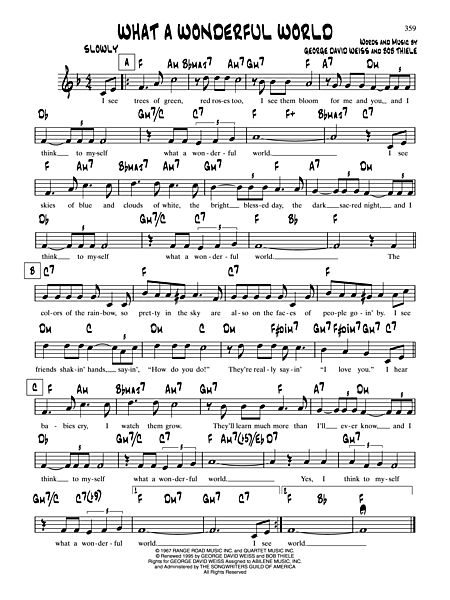 On this last point, take a moment to look at a traditional lead sheet of What a Wonderful World from Sheet Music Plus. There are THREE lines of information here:
On this last point, take a moment to look at a traditional lead sheet of What a Wonderful World from Sheet Music Plus. There are THREE lines of information here:
- The lyrics
- The melody above the lyrics
- The chords above the melody
This is awesome if you don’t know the song, because you can learn a basic sketch of it from this information. However, it is lousy at forming a mental picture of the song in your mind because you’re trying to deal with 3 separate lines of info (trying to read left/right and up/down at the same time). By getting rid of the melody (which hopefully, we already know) and condensing the chords and lyrics of the song to a single line, we make it easier to memorize the chord patterns in the song. For example, as you look at the first lines of each of the verses of this song, the chord pattern and the one place it deviates (an A7* before the third verse) become really obvious and easy to commit to memory:
What A Wonderful World
By George David Weiss and Bob Thiele
I see [D]trees of [F#m]green, [G]red roses [F#m]too
[Em7] I see them [D]bloom for [F#7]me and for [Bm7]you
And I [Bb]think to myself [Em7] what a [A7]wonderful [D]world [Bm7] [Gmaj7] [A7]
I see [D]skies of [F#m]blue and [G]clouds of [F#m]white
[Em7] The bright blessed [D]day, and the [F#7]dark sacred [Bm7]night
And I [Bb]think to myself [Em7] what a [A7]wonderful [D]world [G] [G] [D]
The [A7]colors of the rainbow so [D]pretty in the sky
Are [A7]also on the faces of [D]people going by
I see [Bm7]friends shaking [F#m]hands saying [Bm7]how do you [F#m]do
[Em7]They’re really [F#dim7]saying [Em7]I [F#dim7]love [Em7]you
[A7]I hear [D]babies [F#m]cry, [G] I watch them [F#m]grow
[Em7] They’ll learn much [D]more than [F#7]I’ll ever [Bm7]know
And I [Bb]think to myself [Em7] what a [A7]wonderful [D]world [Fdim 2020] [B7]
Yes I [Em7]think to myself [A7] what a [C#dim7]wonderful [D]world [G6] [Gm6] [D]
In this version, I was also able to quickly fix errors the original transcriber made in both lyrics and chords, change the key, substitute some jazzier chords, and note that an Fdim (without a 7) is fingered 2020 on the ukulele fretboard.
That said, traditional lead sheets and full scores still play an important role in musical learning, so don’t throw the baby out with the bathwater. 🙂
*Of course, another way of looking at the A7 is that it really belongs to the end of the bridge section, in which case it should be moved to the end of ‘I love you’ in the previous line. If you think of it this way, all three first lines of the verses have an identical pattern.
More Music for Ukulele Ensembles! Blackbird, Over the Rainbow & More.
I just finished a round of arranging songs for UFO HUM‘s next concert; these 100% legal arrangements for ukulele ensembles (royalties make their way back to the copyright holders) are available through a special arrangement with Sheet Music Plus. Here are the new titles:
- The Bare Necessities (from Disney’s The Jungle Book)
- Blackbird (The Beatles)
- Don’t Worry, Be Happy (Bobby McFerrin)
- Lean on Me
- Over the Rainbow (from The Wizard of OZ)
- Viva La Vida (Coldplay)
- You’re Never Fully Dressed Without a Smile (from Annie)
You can check out more titles released before Christmas on the For Ukulele Ensembles page of this site.
New Music for Ukulele Ensembles plus Freebies
I’ve created a new page, For Ukulele Ensembles, with music I’ve arranged for 3 or more ukulele players. The page currently contains a couple of BLACK FRIDAY FREEBIES (Canon in C, and I’ll Fly Away), as well as a number of popular Christmas songs (Feliz Navidad, It’s Beginning To Look Like Christmas, The Little Drummer Boy, Sleigh Ride, Silver Bells, You’re a Mean One, Mr. Grinch).
I’ll be adding arrangements of Best Day of My Life : American Authors, Music of the Night : Andrew Lloyd Webber, Happy : Pharrell Williams and more in 2017!
Unlike a lot you find on the internet, these are 100% legal arrangements (royalties make their way back to the copyright holders) through an agreement with SMP Press who works with Hal Leornard music publishing.
I hope you enjoy these with your own ukulele trios, ensembles, bands and orchestras. Happy Holidays!
First Melodies for Ukulele : Free eBook
- First Melodies for Ukulele : 18 familiar tunes to help folk get started with tablature. Includes tablature and staff notation so you can get to know the notes on your fretboard better at the same time.
I put this together for my beginning ukulele students, but thought others might benefit as well. Enjoy!
Christmas is Coming!
Get more ukulele books for your friends and loved ones this holiday season . . .
- NEW! The 2-Chord Christmas Songbook : EASY UKULELE TAB EDITION
- Top 25 Celtic Session Tunes for Ukulele : Popular Tunes in Tab & Notation
- The Ultimate Dictionary of Strum Patterns : for Ukulele Nerds Only
- Titan M’s 2 Chord Companion : 157 songs in Ukulele-Friendly Keys
- Christmas Carols for Ukulele Orchestra : 12 Classic Carols
- The Haunted Ukulele : 59 Spooky Songs to Cast a Spell on Your Audience
- Christmas on 34th Street : 34 3-4 Chord Christmas Classics for Ukulele
- Two Chord Camp Songs for Ukulele : 32 Silly, Funny, Crazy Songs
- The Two Chord Christmas Songbook : 34 Lesser-known Christmas Gems
I <3 the Mountains - Whiteboard
Today my weekly Two Trees ukulele youth class went over the classic camp song, I Love the Mountains. The repeating chord pattern is a great one for beginners. We also talked about transposition and bringing the song up from the key of C (which is easy, but I find a little low for my voice) to the key of F. I took some shots of the white board and thought I’d pass them along.
Note that some versions of the song use the pattern C-C-Am-Am-Dm-Dm-G7-G7 instead of C-C-Am-Am-F-F-G7-G7. This would translate in the key of F to F-F-Dm-Dm-Gm-Gm-C7-C7 instead of F-F-Dm-Dm-Bb-Bb-C7-C7 and as Gm is easier than Bb for beginners it might be the way to go.
Annual Ukulele Popularity Cycle
This is mainly a bit of random trivia, but if I asked you what month of the year is the ukulele most popular, wouldn’t you choose a Summer month? Would you believe that if you use Google Trends to track the term ukulele (click for detailed data) that you’d find that December is consistently, year after year, the time when people are searching for info on ukuleles? Could it be this is just when people are searching for ukuleles as gifts for Christmas? or is it possible that people need a little ukulele time in the dead of winter? I’d probably go with the Christmas theory.
The next most popular time of year for the ukulele is the Summer months (which seems to make sense to me) with the Fall dipping to the low point for the year (perhaps because folks are busy with the business of getting back to school?).
Anyway, I just found this regular pattern (it almost looks like a musical waveform) so interesting that I felt inspired to share. I’d love to hear what other people think of the pattern; please feel free to propose your theories in the comments section below.
Also, anyone hazard a guess as to what caused that uncharactaristic spike in June of 2011 that disrupts the regular pattern?
Overcoming Sheet Music Addiction
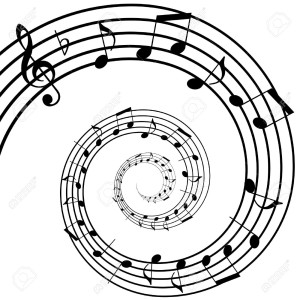 or Confessions of a Sheet Music Addict
or Confessions of a Sheet Music Addict
The last few weeks have been pretty important for me in overcoming one of my SECRET FEARS . . . performing WITHOUT sheet music.
I know it doesn’t sound that frightening or serious, but its a big deal to me. I did my undergraduate degree in vocal performance, so I’m no stranger to performing memorized songs where someone else is accompanying (I memorized whole opera roles for heaven’s sake). However, adding that extra layer of accompaniment, strumming and fingerpicking on my not-very-simple homespun ukulele songs (I did my graduate degree in composition and its not uncommon for me to use a dozen different chords in a song) has been truly terrifying and has stopped me from pursuing more live performance opportunities than I would’ve liked to. This make me sad.
So why not just use a stand? The Ukulele Orchestra of Great Britain uses sheet music! Fine, when I’m doing a cover or performing with a group, but I just can’t bear the thought of performing my own music with a stand between me and the audience. It’s hard enough to connect with a group of strangers on a set of completely unknown songs without the additional barrier of a music stand between you and the audience, let alone without the task of dividing your attention between the score and their faces. Honestly, even in music I’ve written, I can’t help but lose my place glancing back and forth like that and I should know the music better than anyone; I wrote it.
I’ve been playing uke for a little over 5 years now (got my first uke as a present for Christmas of 2010) and I finally am beginning to feel like my skills are at a performable level for self-accompaniment. I also feel like it is time to take it to the next level. I’ll be doing a 30-minute set of original, mostly never-before-performed songs at Thanksgiving Point’s Tullip Festival this coming Saturday (April 16, 2016) at 11am . . . and I won’t be bringing a music stand with me. So, what am I doing to work toward this goal?
REALIZATION
For a long time I labored under the assumption that if I just played a song enough times that eventually I would have it memorized through sheer repetition; that’s how I memorized songs at the university (keeping tally marks at the top of a score to tell me how many times I’d done a particular piece). Well, this was NOT working for me with self-accompaniment on the ukulele. In fact, I found as long as kept my eyes on the score I wasn’t memorizing the chords OR the words no matter how many times I repeated the song. It turns out my brain has figured out that if I always have a visual reminder then there is no need to commit the information to memory. Dang lazy brain! I just have to admit it, I am a recovering sheet music addict.
CHANGE OF TACTICS
Here are some steps that I believe are helping me in my recovery:
- I’ve sung these songs a lot of times. I can perform all the chord changes and accompanimental patterns flawlessly while singing emotively. This was a necessary first step, I needed that familiarity, but now is the time to move on.
- I stopped looking at the score and struggled through the songs passage by passage. Often I would forget which chord belonged where. When I made a mistake I would back up to the beginning of the phrase or section and go through it until I could do it right a few times in a row. Then I moved on until I came across another trouble spot. In this way I was eventually able to ‘connect-the-dots’ and make it through whole songs.
- I created cards that just showed the chord change patterns for an entire song with no words, melody or notes on strumming/fingerpicking. I did use these a few times and I think they helped me see the patterns in my own music better. Recognizing a pattern is very helpful to the brain in memorization.
- I timed all the songs and then ordered the songs and printed out a ‘set list’ for the upcoming performance. I am carrying this set list in my wallet and am making sure my ukulele is with me whenever I’m out an about in case I have a few moments to go through one or more songs.
In a few weeks, I’ve gone from having just one of my songs memorized to ten songs near ready to go. I’m still making mistakes and need to do a lot more reps of my set list in the coming week, but I’m encouraged by the progress I’m making. Hopefully, the distractions of live performance in a park setting won’t prove too much for me and turn this all into a disaster, but I have hope and recently read an interesting article on stage fright that had some pointers I think will really help. Here’s hoping I’ll ‘break a leg’!
CONCLUSION
It turns out the memorization process for me is just a brutal slog and I have to be disciplined enough not to go running back to the music unless I really can’t figure out a section. If you have any tips or ideas, things that help you memorize music, I’d love to hear about them in the comments. Thanks!
Happy Easter! : That Easter Morn Tab Arrangement
- That Easter Morn (PDF)
- Get the source files (Finale, Music XML, JPG and PDF in one ZIP file) at Joyful Noise! LDS Ukulele on Facebook under the Files tab.
Hope you enjoy this arrangement of Robert Cundick’s lovely Easter hymn. You can find the original hymn tune and words here: That Easter Morn at LDS.org
Happy Easter!
Chord Melody Arranging Part 2 : Transposing
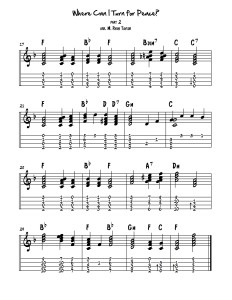 In the first part of this series I talked about some principles of chord melody arranging using the melody in the original vocal range with mostly ‘open position’ chords (the easy ones). This second part will talk about transposing the melody into standard ukulele range and using inversions of chords that are ‘up the neck.’ First you may want to print out a copy of the arrangement I’m using as an example:
In the first part of this series I talked about some principles of chord melody arranging using the melody in the original vocal range with mostly ‘open position’ chords (the easy ones). This second part will talk about transposing the melody into standard ukulele range and using inversions of chords that are ‘up the neck.’ First you may want to print out a copy of the arrangement I’m using as an example:
- Where Can I Turn for Peace (updated version with second page and added chord indications for reference purposes)
Transposing
One of the problems of arranging vocal melodies for the ukulele is that they tend to dip below the middle C that is the bottom of standard ukulele range. This is one of the main reasons there are strong supporters of low-G tuning, like James Hill (except for the Canadians it is low-A tuning). We tackled this challenge in part 1 of this series by transposing a section of the melody up an octave. Another common method of dealing with this problem is to transpose the entire melody up into ukulele range. Here are some steps that may help you with this process, using the second page of “Where Can I Turn for Peace?” as an example:
- Identify the lowest note in the melody you wish to arrange. In the example, the lowest note was an A below middle C with is a ‘minor third‘ (a whole-step plus a half-step) below the range of a standard-tuned uke. That means that in order to bring this into range we have to move all the notes up by at least a minor third.
- Bringing this melody up by a minor third would take us from the key of C (no sharps or flats) to the key of Eb (three flats). There aren’t a ton of open chords in that key, so I chose to go up another step higher to the key of F, which is a ‘perfect fourth‘ (two whole-steps plus a half-step) higher than the key of C. This key only has one flat in the key signature with a number of ‘open’ chord options.
- You’ll find the keys closest to C around the circle of fifths (learn more on wikipedia) are the easiest keys to play on the ukulele: F and G. These would be followed by D, A and Bb. These are generalizations; you might find the best key to transpose to is something odd, like Db (probably not).
- Whatever key you move to, you must make sure you move all the notes by the same interval. In this piece I’ve transposed up by a perfect fourth, so C becomes F, F becomes Bb, D becomes G, and so on.
- All of your chords need to be transposed up by the same interval; a C chord becomes an F chord, an F chord becomes a Bb chord, and so on.
- Once you have your melody and chords transposed you can begin looking for chord inversions that highlight the melody notes. You’ll be looking for notes to land on the 1st/A-string (see the first chord of measure 17) or on the 4th/G-string (see the last chord in measure 20). If the note is below these on the middle strings you can always strum a partial chord (see the first chord in measure 24).
- If you aren’t familiar with a ton of ‘up the neck’ chord inversions, cheat. Either use a ukulele chord dictionary or an online chord finder (ukebuddy.com). A reference makes it so much easier (I use one).
- If a melody note doesn’t belong to a chord (which happens often), you’ll need to add it to the chord (see the Bb on top of an F chord in measure 17 and the E on top of the Bdim7 in measure 19).
That’s about all there is to it. One of the awesome things about chord melody solos of this kind are that they force you to learn all those wonderful ‘up the neck’ chord inversions, opening all kinds of options for your playing, both instrumental and accompanimental.
Notation/tablature software (I use Finale, but there are free options like MuseScore) can help with transposing and take some of the chore out of it (of course, these have a learning curve of their own). Whatever method you use and however long it takes you to get there, there is nothing like the satisfaction of playing your own arrangement of a song.
Source Files
Get the source files (pdf, finale and music xml for import into other music editors) for the above arrangement under the ‘Files’ tab of the Joyful Noise! LDS Ukulele group on FaceBook. Also, if you’re interested in sharing your arrangements of hymns and Christ-centered spiritual songs, this is a great place to do it.

